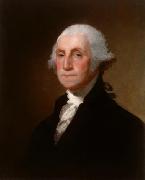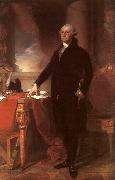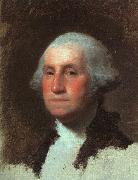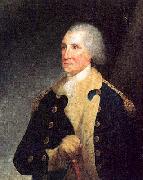
|
Gilbert Charles Stuart
|
|||
|
|
|||
| 1755-1828 Gilbert Charles Stuart Locations Gilbert Charles Stuart (born Stewart) (December 3, 1755 ?C July 9, 1828) was an American painter from Rhode Island. Gilbert Stuart is widely considered to be one of America's foremost portraitists. His best known work, the unfinished portrait of George Washington that is sometimes referred to as The Athenaeum, was begun in 1796 and left incomplete at the time of Stuart's death in 1828. The image of George Washington featured in the painting has appeared on the United States one-dollar bill for over one century. Throughout his career, Gilbert Stuart produced portraits of over 1,000 people, including the first six Presidents of the United States. His work can be found today at art museums across the United States and the United Kingdom, most notably the Metropolitan Museum of Art in New York City, the National Gallery of Art in Washington, D.C., the National Portrait Gallery in London, and the Museum of Fine Arts in Boston. | |||
|
|
|||
|
George Washington Gilbert Charles Stuart5.jpg Painting ID:: 4520 |
1821 26 3/8" x 21 5/8" National Gallery of Art, Washington DC | ||
|
|
|||
|
Gilbert Charles Stuart
|
|||
|
|
|||
| 1755-1828 Gilbert Charles Stuart Locations Gilbert Charles Stuart (born Stewart) (December 3, 1755 ?C July 9, 1828) was an American painter from Rhode Island. Gilbert Stuart is widely considered to be one of America's foremost portraitists. His best known work, the unfinished portrait of George Washington that is sometimes referred to as The Athenaeum, was begun in 1796 and left incomplete at the time of Stuart's death in 1828. The image of George Washington featured in the painting has appeared on the United States one-dollar bill for over one century. Throughout his career, Gilbert Stuart produced portraits of over 1,000 people, including the first six Presidents of the United States. His work can be found today at art museums across the United States and the United Kingdom, most notably the Metropolitan Museum of Art in New York City, the National Gallery of Art in Washington, D.C., the National Portrait Gallery in London, and the Museum of Fine Arts in Boston. | |||
|
|
|||
|
George Washington Gilbert Charles Stuart30.jpg Painting ID:: 4545 |
1796 The New York Public Library, New York | ||
|
|
|||
|
Gilbert Charles Stuart
|
|||
|
|
|||
| 1755-1828 Gilbert Charles Stuart Locations Gilbert Charles Stuart (born Stewart) (December 3, 1755 ?C July 9, 1828) was an American painter from Rhode Island. Gilbert Stuart is widely considered to be one of America's foremost portraitists. His best known work, the unfinished portrait of George Washington that is sometimes referred to as The Athenaeum, was begun in 1796 and left incomplete at the time of Stuart's death in 1828. The image of George Washington featured in the painting has appeared on the United States one-dollar bill for over one century. Throughout his career, Gilbert Stuart produced portraits of over 1,000 people, including the first six Presidents of the United States. His work can be found today at art museums across the United States and the United Kingdom, most notably the Metropolitan Museum of Art in New York City, the National Gallery of Art in Washington, D.C., the National Portrait Gallery in London, and the Museum of Fine Arts in Boston. | |||
|
|
|||
|
George Washington Gilbert Charles Stuart32.jpg Painting ID:: 4547 |
1796 The National Portrait Gallery, Smithsonian Institute, Washington DC | ||
|
|
|||
|
Pine, Robert Edge
|
|||
|
|
|||
| American, 1720-88 English painter, active also in America. His father, John Pine (1691-1756), was a well-known engraver and printseller of whom William Hogarth painted a portrait (c. 1755; Fredericton, NB, Beaverbrook A.G.). Robert Edge Pine was initially considered to have the potential to rival Joshua Reynolds as a portrait painter, a promise derived from such works as the full-length portrait of George II (1759; Audley End, Essex), painted without a sitting being granted him by the King. In 1760 he won a premium at the Society of Arts, London, for a history painting, the Surrender of Calais to Edward III, also known as the Burghers of Calais (untraced), which was engraved in 1762 by Fran?ois Germain Aliamet (1734-88), and another in 1763 for Canute the Great Reproving his Courtiers for their Impious Flattery (untraced), also engraved by Aliamet. Pine was not invited to become a founder-member of the Royal Academy in 1768, probably because of his radical politics; that year he painted a portrait of the political agitator John Wilkes (London, Westminster Hall). In 1772 he left the Society of Arts following a quarrel over its choice of directors; he moved to Bath, where he joined his brother, Simon Pine (d Aug 1772), a painter of miniatures. Their sister was married to the landscape painter Alexander Cozens. While at Bath Pine painted his most ambitious family group, | |||
|
|
|||
|
George Washington new5/Pine, Robert Edge-528737.jpg Painting ID:: 19888 |
1785 Oil on canvas Warner Collection. | ||
|
|
|||
|
Gilbert Stuart
|
|||
|
|
|||
| 1755-1828 Gilbert Stuart was born in North Kingston, R.I., on Dec. 3, 1755. At the age of 13 or 14 he studied art with the Scottish painter Cosmo Alexander in Newport. With Alexander he made a tour of the South and a journey to Edinburgh, where Alexander died in 1772. For about a year Stuart remained, poverty-stricken, in Scotland, but finally, working as a sailor, he managed to get back to America. There he executed a few portraits in a hard limner fashion. With the Revolutionary War threatening, his family, who had Tory sympathies, fled to Nova Scotia, and Stuart sailed for London, where he remained from 1775 to 1787. For the first 4 or 5 years, Stuart served as the first assistant of American expatriate painter Benjamin West, who had rescued him from poverty. From the first, Stuart showed an interest only in portraiture and had no desire to go into the branch of history painting West practiced. After his apprenticeship, Stuart became London's leading portrait painter, next to Joshua Reynolds and Thomas Gainsborough, whose style he emulated, as in a rare full-length portrait of William Grant of Congalton as The Skater (ca. 1782). For a while Stuart lived in splendor, but being a bad businessman and a profligate spender, he was in constant debt. He lived in Ireland from 1787 to 1792 and then returned to America to make a fortune, | |||
|
|
|||
|
George Washington new4/Gilbert Stuart-896864.jpg Painting ID:: 31678 |
mk75 1795 Huile sur toile 76.8x64.1cm | ||
|
|
|||
|
Also Buy::. For Following Paintings / Artists / Products, Please Use Our Search Online: |












